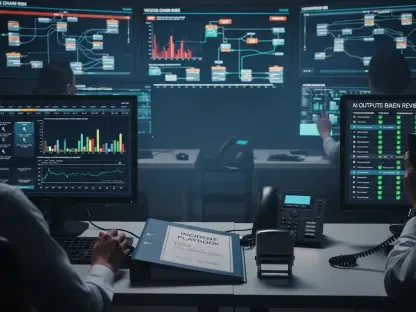Network Security Policy Management (NSPM) is an indispensable component in today’s landscape of cybersecurity, where the complexity brought on by hybrid environments demands a comprehensive and sophisticated approach to managing network security. Ensuring protection against vulnerabilities and maintaining compliance are critical, and NSPM addresses these challenges through a framework that integrates visibility, automation, and proactive risk mitigation. This synergy enables organizations to systematically streamline their security management processes while adhering to evolving standards.
The Significance of NSPM
Addressing Vulnerabilities and Compliance
In an era where hybrid environments seamlessly merge on-premises systems with public and private cloud services, the vast diversity of infrastructures introduces numerous security risks and complexities. Proper identification of misconfigurations and assurance of compliance become crucial tasks. NSPM is pivotal in this context, as it plays an essential role in pinpointing these vulnerabilities and addressing compliance gaps. This function underscores NSPM’s importance in contemporary cybersecurity strategies. The market potential of NSPM, which is projected to exceed $36 billion by 2032, further emphasizes its significance in mitigating risks and enabling seamless policy management across various organizational setups.
Early Adoption and Recognition
The early adoption of hybrid networks has ushered in a set of challenges that validate the necessity of NSPM. As organizations began integrating complex infrastructures, the benefits of NSPM became increasingly apparent. Gartner’s formal acknowledgment of NSPM as an essential category within cybersecurity exemplifies its growing importance. Businesses that have integrated NSPM into their operations have experienced first-hand improvements in the management of their security policies across multifaceted infrastructures. This positive impact has led to widespread acceptance and integration of NSPM, making it a crucial component in the strategies of various organizations aiming to enhance their cybersecurity framework.
Core Components of NSPM
Centralized Visibility
One of the foundational pillars of NSPM is centralized visibility, which provides organizations with a holistic view of their security posture. This comprehensive visibility ensures that no facet of the network remains unchecked. By amalgamating data from hybrid and multicloud environments, NSPM effectively eradicates blind spots, enabling proactive identification and management of vulnerabilities before they transform into significant security threats. This centralized approach not only bolsters security measures but also increases transparency, making it easier for security teams to monitor and address issues across the entire network ecosystem.
Automated Policy Management
Automation within the NSPM framework significantly reduces the dependency on manual processes, which are often error-prone. Automated policy management ensures the consistent application of security rules across the network, consequently optimizing workflows and diminishing the likelihood of misconfigurations. This transition towards automation permits cybersecurity teams to concentrate on more strategic initiatives, such as threat response and in-depth analysis. Automation streamlines operations and fosters a robust security protocol that can adjust swiftly to emerging threats and dynamic network demands.
Proactive Risk Mitigation
A key differentiator of NSPM from traditional reactive methods is its proactive approach to risk mitigation. Real-time monitoring and automated alerts enable organizations to preemptively tackle potential threats, maintaining continuous compliance with industry standards. This shift from a reactive to a proactive stance fortifies an organization’s defenses and minimizes the impact of emerging cybersecurity threats. The proactive nature of NSPM ensures that potential vulnerabilities are addressed promptly, thereby solidifying the organization’s security framework and enhancing overall cyber resilience.
Implementation Challenges
Integration with Existing Infrastructures
Even with its myriad advantages, seamlessly integrating NSPM with existing diverse security infrastructures presents challenges. Organizations typically deploy various security tools and configurations, necessitating thorough planning and coordination for successful NSPM adoption. Effective integration demands a meticulous assessment and adaptation of current policies to align them with NSPM frameworks. This involves reassessing existing security measures, redefining policy parameters, and ensuring they fit coherently within the NSPM structure. Such a detailed integration process can be resource-intensive but is critical for the establishment of a seamless NSPM system.
Overcoming Automation Resistance
Transitioning from manual to automated policy management often encounters resistance from security personnel apprehensive about relinquishing direct control. Addressing these concerns requires a phased, strategic approach. Initiating the automation process with low-risk policies allows teams to gradually become accustomed to automated management. As confidence builds, organizations can incrementally extend automation to more critical functions. Incorporating comprehensive training programs can further mitigate apprehensions, ensuring teams are well-prepared for the transition. This gradual adoption combined with continuous education can effectively smooth the implementation process, fostering a culture that embraces automated solutions.
Continual Optimization
The importance of translating enhanced security visibility into actionable improvements cannot be overstated. Simply consolidating security data is not sufficient; there must be regular assessments and optimizations of the rulesets governing the security policies. Continuous internal security audits play a pivotal role in this process, as they help to identify inefficiencies and areas needing refinement. This perpetual optimization ensures that the NSPM’s impact remains potent and that the security measures evolve in alignment with emerging threats and organizational growth. By maintaining an agile and responsive security framework, organizations can maximize their NSPM’s effectiveness.
Future-Proofing Cybersecurity Strategies
Adaptation and Scalability
As network environments continue to evolve and grow in complexity, the adaptability and scalability of NSPM become increasingly important. Its vendor-neutral methodology ensures its seamless application across various technology stacks, making it versatile and universally compatible. This flexibility allows organizations to future-proof their cybersecurity strategies, adapting to changes and scaling their security measures as needed. By embracing NSPM’s integrated solutions, enterprises can maintain robust defenses against continuously evolving threats and ensure their cybersecurity frameworks remain resilient and scalable amidst dynamic digital landscapes.
Operational Efficiency
Network Security Policy Management (NSPM) is a crucial aspect in the realm of modern cybersecurity. With the rise of hybrid environments, the complexity of managing network security has grown significantly. To effectively protect against vulnerabilities and ensure compliance with industry standards, a sophisticated and comprehensive approach is necessary. NSPM offers a solution through its framework that incorporates visibility, automation, and proactive risk mitigation. The integration of these components allows organizations to efficiently streamline their security management processes. By adopting NSPM, companies can stay aligned with evolving regulations and standards while enhancing their overall security posture. This approach not only safeguards the network’s integrity but also boosts its resilience against potential threats. In summary, NSPM is essential for maintaining robust cybersecurity in today’s intricate digital landscape.









